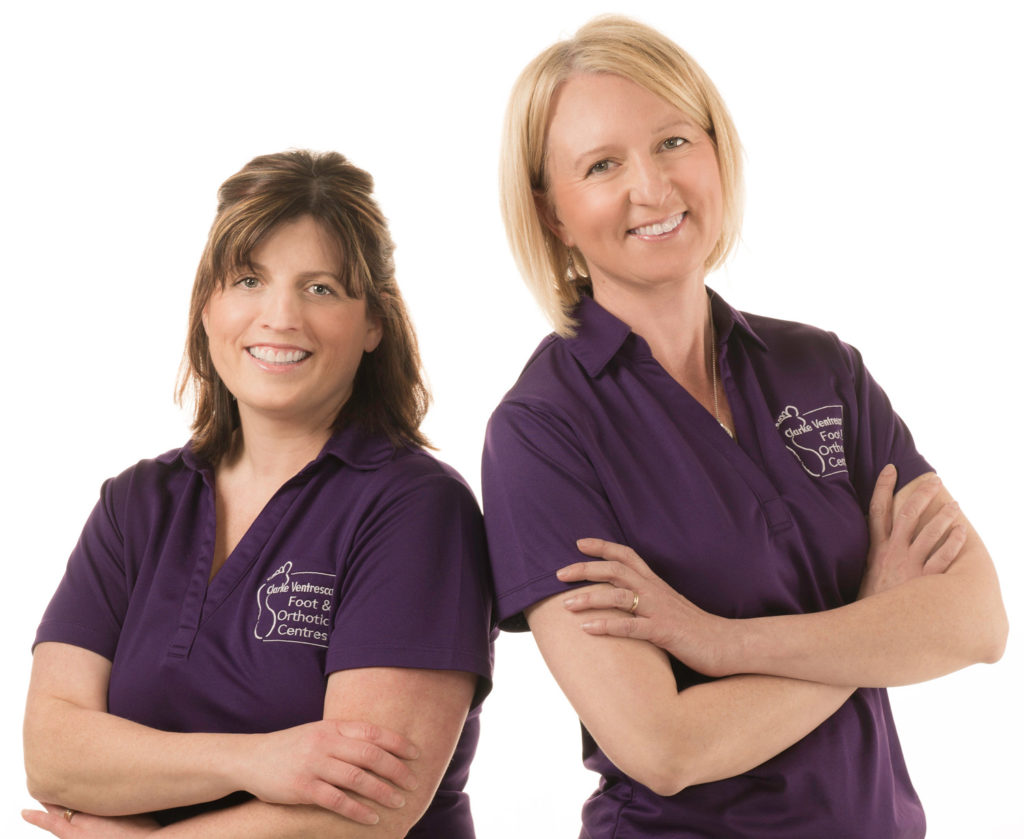We Know Feet
Your feet connect with the rest of your body much more than you think. There are many underlying illnesses or conditions that put your legs and feet at increased risk of injury and disability. The health of your feet can be critical to your mobility and have a direct relationship with your general well-being.
Relieve Unnecessary Foot Pain Now!

We are here to help!
You do not need to suffer any longer!
The average person walks approximately 115,000 miles in a lifetime – more than four times the circumference of the earth. Is it any wonder why 3 out of 4 people will experience foot pain during their lifetime? If you are suffering from heel and arch pain, ingrown toenails, pain from callous or corns, bunions and hammer toes or perhaps you simply need help with cutting your toenails we are here to help.
Custom Foot Orthotics
Custom made orthotics are prescription medical devices designed to alter the forces exerted on the foot in an effort to alleviate foot pain or over use injuries. Orthotics make standing, walking, and running more comfortable and efficient by altering the angles at which the foot strikes the ground. Orthotics placed inside your shoes can absorb shock, improve balance, and take pressure off sore spots. Like eyeglasses and dentures, they are custom made to work for you and only work while you are wearing them. There are three broad categories of orthotics.
- Those that primarily attempt to change foot function;
- Those that are mainly protective in nature; and
- Those that combine both functional control and protection.
Orthotics come in many different shapes and sizes and are constructed out of various materials. While orthotics can be made by several different processes, the gold standard continues to be a physical examination of the foot which includes a dynamic analysis of your walking cycle, followed by a non-weight-bearing plaster mold of your feet. Orthotics should fit into any properly designed footwear that fit well.
At Clarke Ventresca Foot & Orthotic Centres there will be a hands-on biomechanical evaluation of the lower limbs, including foot structure, alignment, strength, range of motion, soft-tissue damage, as well as the identification of any abnormalities. This will be followed by a gait analysis, where you will be observed standing, then walking. This will identify abnormalities or compensations occurring through your legs. Putting this altogether, a diagnosis can be made and a custom orthotic will be designed just for you.
Remember it is not normal to have foot pain. Call us we can help.
The Diabetic Foot
It is estimated that 2,000,000 Canadians are affected by diabetes and many more are not even aware of it. This disease requires proper management to prevent serious problems. Not taking care of blood sugar levels can lead to impaired circulation and peripheral neuropathy (loss of feeling to the feet). Over many years, this can lead to decreased healing time, ulceration and sometimes amputation.
Diabetes can cause many changes within your body. The main effect to the feet and lower legs is diabetic peripheral neuropathy which often includes symptoms such as pain, burning, tingling, pins and needles and even complete numbness. It is estimated that over 50% of diabetics have some form of peripheral neuropathy but many do not have any symptoms. Poor glucose levels will affect the onset and severity of neuropathy, which ultimately will make walking difficult as it will affect balance. Sleeping is often an issue for diabetics as tingling may keep them awake.
It is important to maintain a proper glucose level as this will allow your body to function more efficiently and will decrease the chance of your developing problems throughout your entire body. Your eyes, cardiovascular system, kidneys and feet will all benefit from proper glucose control.
Diabetics should inspect their feet daily. An annual Comprehensive Diabetic Foot Exam should also be completed. At Clarke Ventresca Foot & Orthotic Centres we will help to determine your risk level and will guide you with the future management of your foot care. A diabetic that is well controlled with no symptoms of nerve damage or diminished circulation is considered low risk.
The next risk level is moderate, where there are some early nerve and circulation concerns thus increasing the risk of infection and complications. At this level it is recommended that diabetics should have a Diabetic Foot Check every 4-6 months. Foot care should also be performed every 6-8 weeks to minimize the chance of any foot problems.
High risk is if you have considerable loss of feeling or no feeling in your feet. You may have already experienced a foot or lower leg ulcer and your circulation is usually poor. High risk diabetic foot care should be performed by a Chiropodist every 4-6 weeks in order to minimize the chance of infection, ulceration or other foot problems.
Below is a list of things that may be checked in your feet during your Diabetic Foot Exam at Clarke Ventresca Foot & Orthotic Centres:
- Pulses in your feet
- Capillary refill time
- Absence of hair growth
- Temperature
- Light touch sensation (using a small monofilament)
- Proprioception
- Gait
- Balance
- Footwear and inserts or orthotics
- Type of socks you wear
If you or someone you care about have diabetes and are concerned about their foot health, call our clinics today.
For more information on Diabetes – please see the Canadian Diabetes Association
Corns and Callous
What is it?
Corns and callous are thick, hard layers of skin that develop from pressure and friction and can form anywhere on the foot. Callous develops as a result of diffuse pressure or friction, where as a corn develops form direct, localized pressure. A corn forms inwards like a cone of callous, and does not have a root.
What can cause it?
Common causes of corns and callous are:
- Poor fitting footwear
- Bunions
- Hammer/Claw toes
- Flat feet
- High arched feet
How can they be treated?
Your chiropodist can remove the corn and callous quite easily with no pain. The chiropodist will make recommendations to prevent the corn and callous from returning. These recommendations may include a change in footwear or custom made orthotics.
Ingrown Toe Nail Removal
What is it?
Ingrown toenails are a painful condition where the nail protrudes into the surrounding skin. This can lead to inflammation and consequently infection if not treated properly. The skin can become red and it will be painful to the touch, making footwear and mobility become increasingly difficult. For people with impaired circulation or diabetes, this can be a serious issue that needs immediate attention.
What can cause it?
- Heredity
- Improper nail trimming
- Trauma to the area
- Pressure from ill-fitting footwear
What can I do to alleviate it?
Ingrown toenails are a common ailment that we deal with here at Clarke Ventresca Foot and Orthotic Centres. In your assessment with our chiropodists we will determine the proper route for treatment and provide you with information on preventing further ingrown toenails from occurring. Finally, if your ingrown toenails keep persisting, you may want to consider a simple surgery that we perform in our office to remove the portion of the nail causing the discomfort. But the first step is making that initial appointment.
Shockwave Therapy
What is shockwave therapy?
Extracorporeal Shockwave Therapy is a series of high-energy percussions applied to the affect area. The Shockwave is a physical sound wave “shock”, not an electric one.
How does it work?
Treatment produces an inflammatory response. The body responds by increasing metabolic activity around the site of pain. This stimulates and accelerates the healing process. Shock wave will also break down scar tissue and/or calcification. Finally transmission of pain is diminished through neurological mechanisms.
At Clarke Ventresca Foot & Orthotic Centres our chiropodists have been certified to provide Shockwave therapy. Shockwave is most commonly used on the foot to treat plantar fasciitis and Achilles Tendinitis. Treatment normally involves three treatments at weekly intervals.
Swift Wart Treatment
What is Swift?
Clarke Ventresca Foot and Orthotic Centres has a new treatment now available for plantar warts. It’s called The Swift! Now The Swift is a different kind of treatment. Instead of using the typical treatments around warts such as freezing, burning or pouring a chemical over it, this new treatment delivers a quick, sharp dose of energy to the tissue, only one millimetre into the skin, leaving the skin intact. No scarring, no blistering!
How does it work?
The Swift works by activating something called the dendritic cells, they tell the body that the virus is present in the skin which sends a signal to the t-cells to clear the infection! Kind of like an army fighting off an invasion. The reason why we are using this new treatment is because when we have a plantar wart the body doesn’t recognize that it is there, making it difficult for your body to fight it off. This new treatment jump starts your immune system and makes it known that the virus is present, so it can’t hide anymore!
The swift has a 95% success rate and you’ll only need 3-4 treatments! The Swift does hurt when used, but not like you would think from burning, freezing of chemicals. It doesn’t leave any scar tissues, nor does it blister after use. You don’t even need a band-aid after the treatment!
Call our clinic today to find out more information about the treatment and book an appointment today!
It is not normal for your feet to hurt.
Meet Caitlyn
Our Procedures
At Clarke Ventresca Foot & Orthotic Centres, you are visiting qualified, registered Chiropodists who provide quality foot care and comprehensive footwear and orthotic counselling for seniors, children, teens, and the general work force. We offer a variety of services to treat any and all foot related issues you may be having.

Custom Made Orthotics
Custom made orthotics are prescription medical devices designed to alter the forces exerted on the foot in an effort to alleviate foot pain or over use injuries.

Compression Socks/Stockings
Compression stockings are specially made, snug-fitting, stretchy socks that gently squeeze your leg and help improve blood flow.

Foot and Heel Pain
Don’t wait to seek attention. The pain can progress rapidly so treatment should be started as early as possible. The longer this condition is left untreated, the more difficult it is to treat.

Shockwave
Extracorporeal Shockwave Therapy is a series of high-energy percussions applied to the affected area. The Shockwave is a physical sound wave “shock”, not an electric one.

Swift Wart Treatment
This treatment delivers a quick, sharp dose of energy to the tissue, only one millimetre into the skin, leaving the skin intact. No scarring, no blistering!

Ingrown Toe Nail Removal
Ingrown toenails are a painful condition where the nail protrudes into the surrounding skin. This can lead to inflammation and consequently infection if not treated properly.

Diabetic Foot Checks
Diabetics should inspect their feet daily. An annual Comprehensive Diabetic Foot Exam should also be completed. We will help to determine your risk level and will guide you with the future management of your foot care.

Treatment and Prevention of Corns and Callous
Corns and callous are thick, hard layers of skin that develop from pressure and friction and can form anywhere on the foot. Our chiropodists will painlessly remove your corns and callous, assess the cause and provide a management plan to prevent recurrence.

Routine Nail Care
No matter what the season is, it is always important to keep your feet and toenails in tip-top condition. Our team will assess the health of your toenails and ensure they are trimmed correctly. The will provide education for proper self-care to ensure your nails and feet stay healthy.
